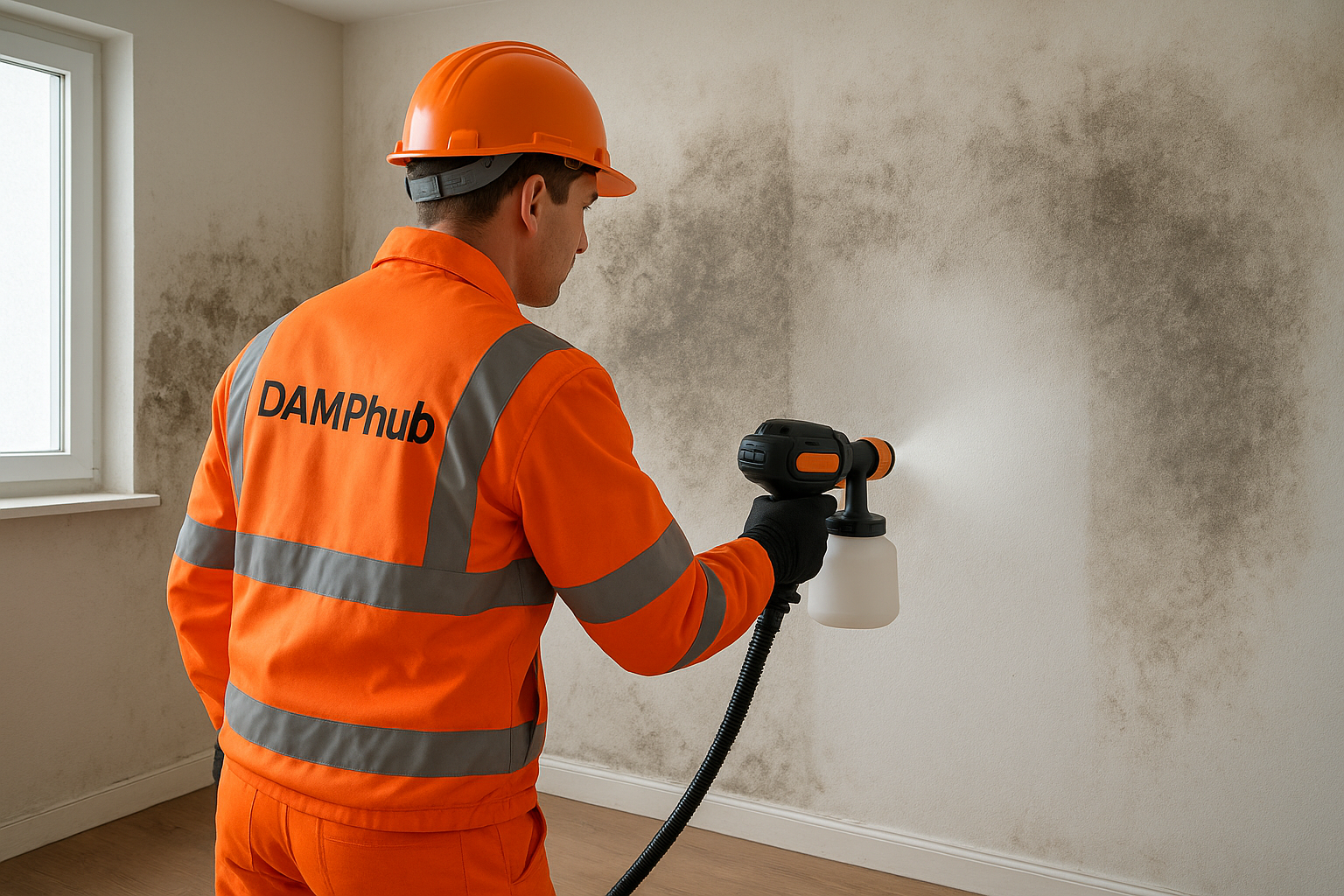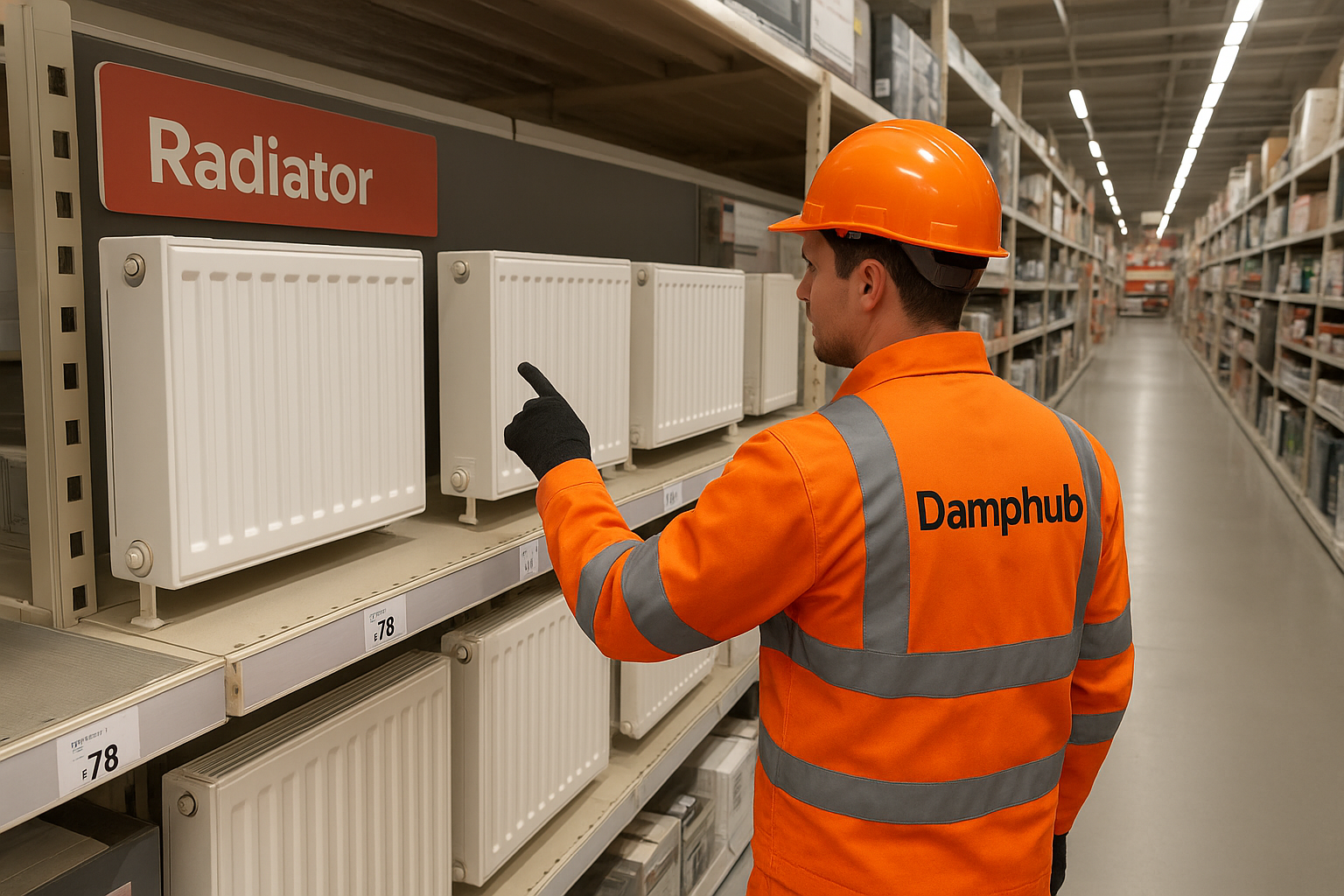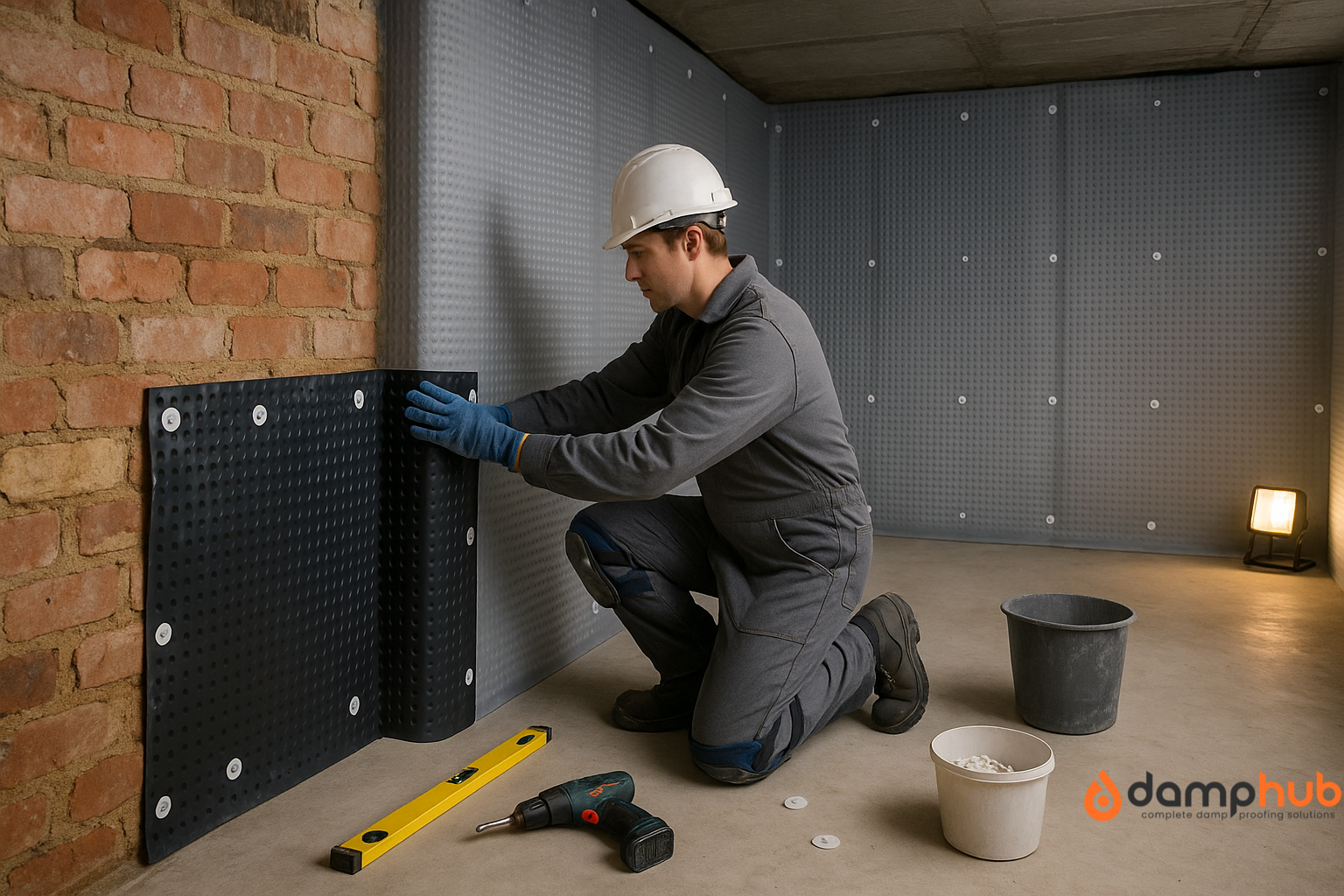
Key Takeaways
- ✓ Basement waterproofing stops leaks at the source — not just on the surface.
- ✓ Foundation leak repair often means sealing cracks and installing drainage.
- ✓ Poor guttering and soil slope are major causes — fix drainage first.
- ✓ Don’t wait for flooding — musty smells and stains are early signs.
- ✓ For lasting results, combine interior and exterior waterproofing methods.
A leaking basement isn’t just inconvenient — it’s stressful. Water on the floor. That damp, sour smell. The creeping worry about damage you can’t even see yet.
And yet, most basement leaks start quietly. Maybe a tiny damp patch after heavy rain. A bit of flaking paint. Or mould forming in one stubborn corner. Ignore it, and you could be staring down structural damage, electrical risks, or ruined belongings.
So let’s break it down. We’ll look at why basements leak, how to fix them properly, and the most effective basement waterproofing methods in the UK — including what actually works for foundation leak repair (and what doesn’t).
👉 Must read: A Complete Guide to Basement Tanking in the UK
First: Why Is Your Basement Leaking?
Before you grab a sealant or call in help, you need to understand what’s letting the water in. Most basement leaks fall into one or more of these categories:
1. Water coming in from outside
This is the most common issue. Rainwater or groundwater seeps in through cracks in the walls or floor, usually after heavy downpours or long spells of wet weather. Poor drainage and a high water table don’t help.
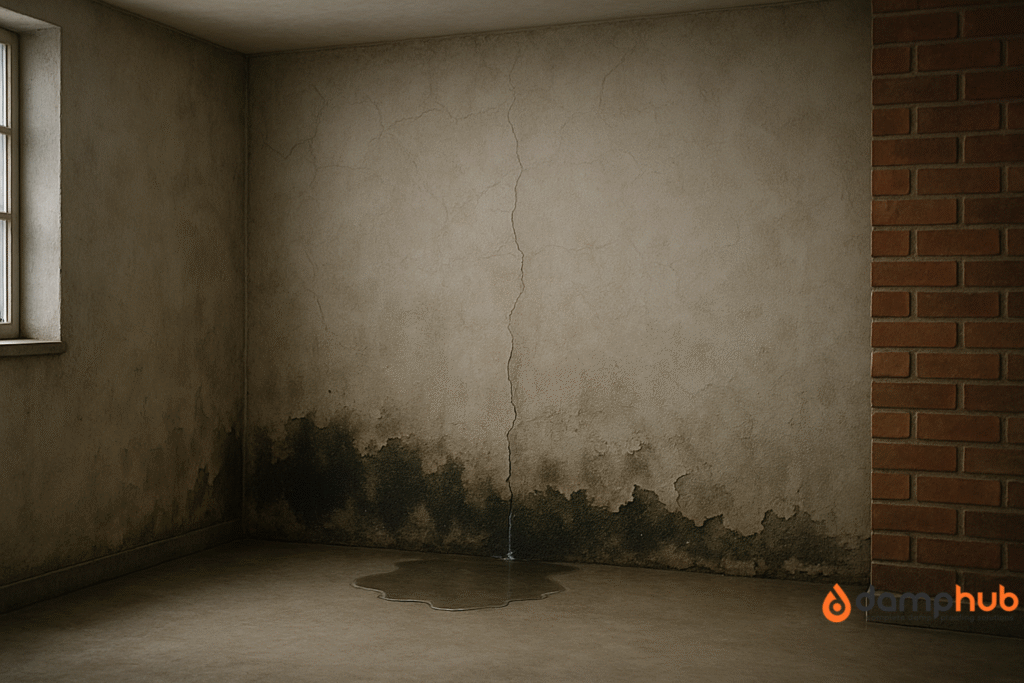
2. Failed or missing damp proofing
Older homes often lack a proper waterproof membrane in the basement. Even newer ones can suffer if the membrane was damaged or poorly installed. That’s where basement waterproofing becomes essential — internally or externally.
3. Plumbing leaks
Sometimes it’s not rain — it’s your pipes. Leaks from internal plumbing, radiators, or old pipework hidden in walls can soak into walls unnoticed for ages.
4. Condensation and poor ventilation
Moist air hitting cold basement walls = trouble. It doesn’t always look dramatic, but over time, it causes mould, rot, and paint to bubble or peel.
What Does a Basement Leak Look Like?
Most basement leaks don’t shout. They whisper through smells, stains, and slow damage.
Here is what you will notice:
- Pooled water near the walls
- Damp patches on walls or the floor
- Efflorescence (white powdery marks)
- Mould, especially in corners
- Peeling paint or discoloured skirting
- Musty smells that don’t go away
Pro Tip:
If you only get water after rain, it’s probably an external leak. If it’s always damp, suspect internal plumbing or condensation.
Best Basement Waterproofing Methods (UK)
There’s no one-size-fits-all fix — what works in one property might be useless in another. But here are the most effective basement waterproofing options used in UK homes:
1. Internal Waterproofing (Tanking)
This involves coating the inside of your basement walls with a waterproof barrier. It doesn’t stop water from entering, but it stops it from coming through. Ideal for basements with mild seepage or patchy moisture.
- Materials: cementitious tanking slurry or bitumen-based products
- Can be DIY-friendly if you prep well
- Works well when paired with good ventilation
2. External Waterproofing
If you can access the outside walls (e.g. during an extension or garden work), apply a waterproof membrane externally. This is often combined with drainage boards and gravel layers to redirect water away from the foundation.
- More expensive
- Usually requires excavation
- Very effective for long-term foundation leak repair
3. French Drains
A classic method for reducing water pressure around your basement. A trench is dug near the foundation, lined with fabric, filled with gravel and a pipe, then covered. It helps direct water away from the building.
- Lowers hydrostatic pressure
- Keeps water from pooling near the walls
- Often paired with sump pumps

4. Sump Pump Systems
If water is getting in, and there’s no easy way to stop it at the source, a sump pump can help. It collects water from under your basement and pumps it safely away.
- Must be professionally installed
- Needs maintenance and power
- Excellent for heavy water ingress
5. Crack Injection for Foundation Leak Repair
Tiny cracks in your concrete walls or floor? Use polyurethane or epoxy injection to seal them internally. This can stop leaks right at the source, without digging.
- A smart first step for foundation leak repair
- Can be a lasting fix for small-scale leaks
How to Fix a Leaking Basement (Step-by-Step)
Let’s assume you’ve already identified where the water is getting in. Here’s a practical plan — whether you’re going DIY or calling in the pros.
Step 1: Find the leak source
Check when the basement gets wet. After rain? Then it’s likely external. Constant dampness? It could be pipes or condensation.
Step 2: Clear everything out
Move furniture, boxes, and flooring away from walls. You’ll need space to inspect and treat the problem properly.
Step 3: Patch visible cracks
Use a specialist crack injection kit or a concrete filler. If you can feel air coming through the crack, water will come too.
Good to Know:
Don’t use household silicone — it won’t hold against hydrostatic pressure.
Step 4: Apply tanking or internal sealant
Coat affected walls and floors with a tanking slurry or waterproof sealant. Always follow the drying time instructions to the letter.
Step 5: Improve ventilation
If condensation’s part of the problem, add a vent, install a small extractor fan, or run a dehumidifier regularly.
Step 6: Direct water away outside
Make sure your gutters and downpipes are working. Extend them to pour water well away from your walls. Slope your garden soil slightly away from the house if possible.
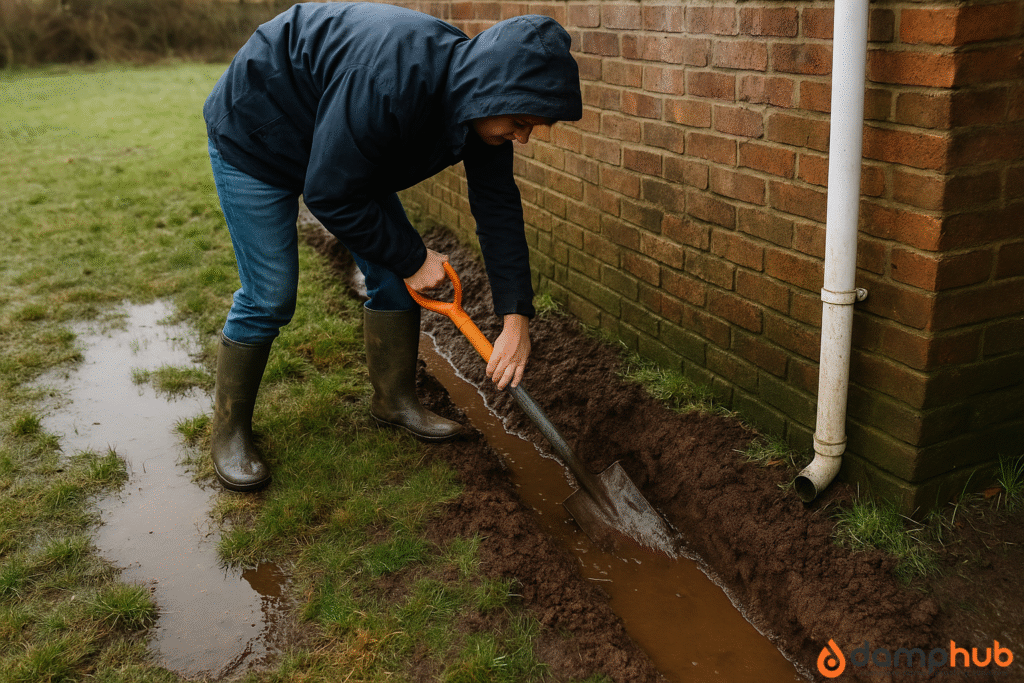
Step 7: Get professional basement waterproofing if needed
If your walls are constantly damp, or water’s coming in no matter what, it’s time to call in a pro. External waterproofing or French drain installation isn’t a DIY job.
Foundation Leak Repair vs General Waterproofing — What’s the Difference?
A quick breakdown:
- Foundation leak repair is about stopping specific cracks or weaknesses in your structure. Think injection, resin sealing, or structural patching.
- Basement waterproofing is the broader fix — it might include membranes, drainage, ventilation, and pumps. It’s about keeping water out long-term.
You often need both. Seal the crack and make sure water’s not being forced in again next time it rains.
How to Prevent Basement Leaks Long-Term
Fixing a leak is one thing. But if you don’t sort out what caused it, there’s every chance it’ll come back — quietly, slowly, and probably worse.
These five simple steps make a big difference in keeping your basement dry for good:
1. Keep gutters and downpipes clear
Leaves, moss, and debris clog things up fast — and when water overflows, it ends up soaking the walls around your basement. Clean them out a couple of times a year, especially in autumn.
2. Make sure the ground slopes away from the house
If the ground outside tilts towards your walls, you’re basically guiding water straight in. You want the soil sloping away, so rain runs off naturally. A subtle slope over a few metres is enough.
3. Fit a drainage channel around the basement
Something like a French drain — either just outside the foundation or inside, under the floor — gives groundwater somewhere else to go. It’s a reliable fix, especially for homes on wet ground.
4. Use a dehumidifier in muggy months
Damp air builds up fast in a basement, and all that condensation can soak into plaster, brick, and wood. A good dehumidifier keeps things dry — especially in summer or rainy spells.

5. Keep an eye on it every year
Even if it seems dry, give your basement a proper once-over each year. Look for hairline cracks, damp patches, and damp smell. Or get a waterproofing expert to check it over for peace of mind.
Pro Tip:
Live somewhere prone to heavy rain or flooding? It’s worth looking into proper membrane systems and backup sump pumps. They’re not cheap — but they can stop thousands of pounds in future damage.
How Much Does Basement Waterproofing Cost in the UK?
Here’s a rough breakdown (2025 prices):
| Method | Typical Cost (UK) |
|---|---|
| Internal Tanking | £1,000 – £3,000 |
| External Waterproofing | £4,000 – £10,000+ |
| French Drain Installation | £2,000 – £6,000 |
| Crack Injection | £300 – £700 per crack |
| Sump Pump Installation | £1,500 – £3,500 |
Note:
Costs vary based on access, property age, basement size, and existing damage. Always get 2–3 quotes.
Is It Worth Fixing a Leaking Basement?
Absolutely. Left untreated, even small leaks:
- Weaken the structure of your home
- Lead to wet/dry rot, mould, and poor air quality
- Ruin flooring, storage, and insulation
- Hurt property value and saleability
Fixing leaks early is always cheaper than paying for major damp treatment later.
Final Thought
If your basement’s leaking, don’t panic — but don’t delay either. Whether it’s a fine hairline crack or an all-out flood, there’s a solution. It might be as simple as sealing a joint or as involved as installing a sump system and full basement waterproofing setup.
What matters is that you tackle the root cause, not just the symptoms. That’s where real foundation leak repair starts.
How To Fix a Leaking Basement: Questions Answered
What is the difference between tanking and damp proofing?
If you’re researching basement waterproofing, you’ll likely hear about tanking and damp proofing. Tanking creates a watertight barrier on internal walls, often used when water is already entering the basement.
Damp proofing is more about controlling minor moisture or condensation. For serious foundation leak repair, tanking tends to be the more effective choice.
Does basement tanking require building regulations?
Tanking itself usually doesn’t need building regs — but if you’re turning the basement into a liveable space after foundation leak repair, then yes, you’ll need approval.
That includes things like ventilation, insulation, and drainage. Always check before starting major basement waterproofing work.
When should I be worried about a wet basement?
A little damp patch might not seem urgent, but when you spot peeling paint, strong odours, or actual water pooling, it’s time to act.
Foundation leak repair should happen before mould and rot spread further. The sooner you look into basement waterproofing, the more damage (and money) you’ll save.
How to remove moisture from a basement without a dehumidifier?
No dehumidifier? Try ventilation, fans, or even moisture-absorbing products. But these are just short-term fixes.
If the moisture is coming through the walls or floor, you’re dealing with a deeper issue — one that calls for real basement waterproofing or even professional foundation leak repair to stop water at the source.
How long does it take for a basement to dry out?
That depends on how much water was there. After a major foundation leak repair, drying out could take several weeks, especially in older properties.
With proper airflow and a working basement waterproofing system in place, you’ll speed things up and prevent the damp from returning.
How long does it take for mould to grow in a damp basement?
Mould can start forming within 24 to 48 hours. If you’ve had even a minor leak, the clock is ticking.
Addressing the cause with solid basement waterproofing and quick foundation leak repair is the only way to stop it from spreading through your home.
Can a damp basement affect upstairs?
Yes — moisture doesn’t stay put. A damp or leaky basement can push humidity upward, affecting timber floors, plaster walls, and even upstairs air quality.
Skipping foundation leak repair often means the problem moves higher over time. A reliable basement waterproofing system keeps the whole house healthier.

